power steering fluid CHRYSLER PT CRUISER 2007 1.G Owners Manual
[x] Cancel search | Manufacturer: CHRYSLER, Model Year: 2007, Model line: PT CRUISER, Model: CHRYSLER PT CRUISER 2007 1.GPages: 467, PDF Size: 7.57 MB
Page 114 of 467

Front seat belt assemblies must be replaced after a
collision. Rear seat belt assemblies must be replaced after
a collision if they have been damaged (bent retractor, torn
webbing, etc. If there is any question regarding belt or
retractor condition, replace the belt.
Airbag Light
The light should come on and remain on for 6 to 8
seconds as a bulb check when the ignition switch is first
turned ON. If the LED is not lit during starting, have it
checked. If the light stays on or comes on while driving,
have the system checked by an authorized dealer.
Defroster
Check operation by selecting the defrost mode and place
the blower control on high speed. You should be able to
feel the air directed against the windshield.
Periodic Safety Checks You Should Make Outside
The Vehicle
Tires
Examine tires for excessive tread wear or uneven wear
patterns. Check for stones, nails, glass, or other objects
lodged in the tread. Inspect tread and sidewall for cuts or
cracks. Check wheel nuts for tightness, and tires (includ-
ing spare) for proper pressure.
Lights
Have someone observe the operation of exterior lights
while you work the controls. Check turn signal and high
beam indicator lights on the instrument panel.
Fluid Leaks
Check area under vehicle after overnight parking for fuel,
engine coolant, oil or other fluid leaks. Also, if gasoline
fumes are detected or fuel, power steering fluid or brake
fluid leaks are suspected, the cause should be located and
corrected immediately.
114 THINGS TO KNOW BEFORE STARTING YOUR VEHICLE
Page 299 of 467
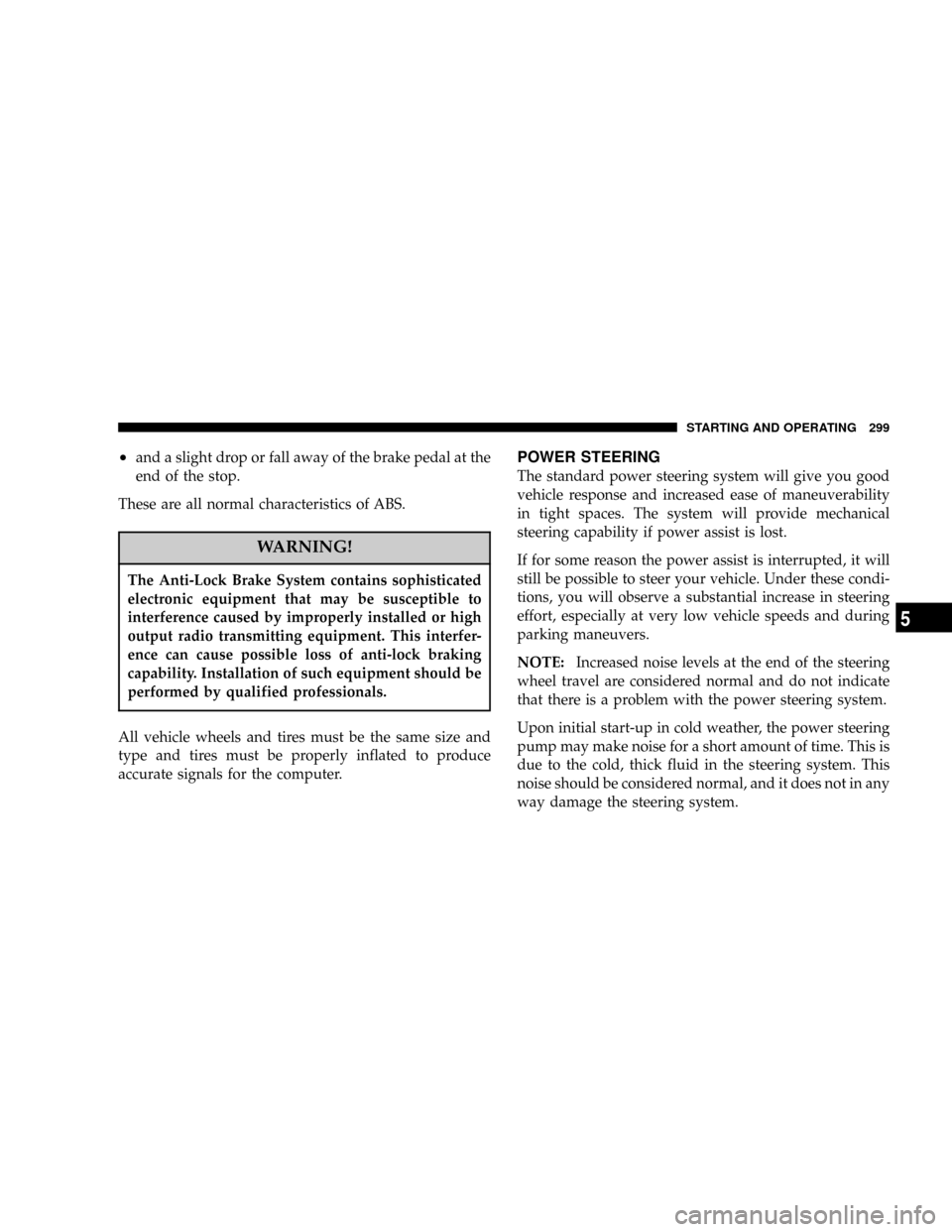
²and a slight drop or fall away of the brake pedal at the
end of the stop.
These are all normal characteristics of ABS.
WARNING!
The Anti-Lock Brake System contains sophisticated
electronic equipment that may be susceptible to
interference caused by improperly installed or high
output radio transmitting equipment. This interfer-
ence can cause possible loss of anti-lock braking
capability. Installation of such equipment should be
performed by qualified professionals.
All vehicle wheels and tires must be the same size and
type and tires must be properly inflated to produce
accurate signals for the computer.
POWER STEERING
The standard power steering system will give you good
vehicle response and increased ease of maneuverability
in tight spaces. The system will provide mechanical
steering capability if power assist is lost.
If for some reason the power assist is interrupted, it will
still be possible to steer your vehicle. Under these condi-
tions, you will observe a substantial increase in steering
effort, especially at very low vehicle speeds and during
parking maneuvers.
NOTE:Increased noise levels at the end of the steering
wheel travel are considered normal and do not indicate
that there is a problem with the power steering system.
Upon initial start-up in cold weather, the power steering
pump may make noise for a short amount of time. This is
due to the cold, thick fluid in the steering system. This
noise should be considered normal, and it does not in any
way damage the steering system.
STARTING AND OPERATING 299
5
Page 300 of 467
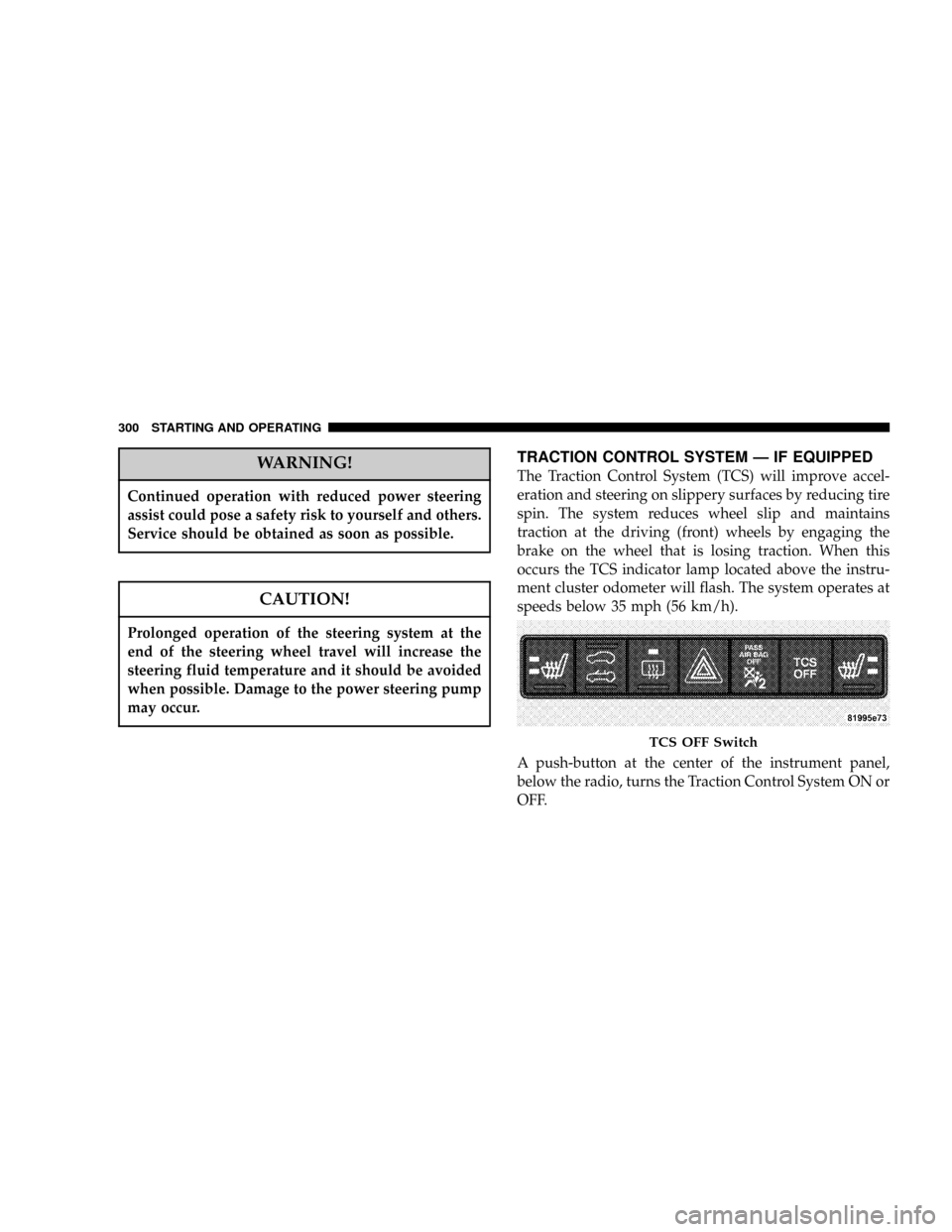
WARNING!
Continued operation with reduced power steering
assist could pose a safety risk to yourself and others.
Service should be obtained as soon as possible.
CAUTION!
Prolonged operation of the steering system at the
end of the steering wheel travel will increase the
steering fluid temperature and it should be avoided
when possible. Damage to the power steering pump
may occur.
TRACTION CONTROL SYSTEM Ð IF EQUIPPED
The Traction Control System (TCS) will improve accel-
eration and steering on slippery surfaces by reducing tire
spin. The system reduces wheel slip and maintains
traction at the driving (front) wheels by engaging the
brake on the wheel that is losing traction. When this
occurs the TCS indicator lamp located above the instru-
ment cluster odometer will flash. The system operates at
speeds below 35 mph (56 km/h).
A push-button at the center of the instrument panel,
below the radio, turns the Traction Control System ON or
OFF.
TCS OFF Switch
300 STARTING AND OPERATING
Page 360 of 467

NMaintenance-Free Battery................375
NAir Conditioner Maintenance.............377
NPower Steering Ð Fluid Check............378
NFront Suspension Ball Joints..............379
NBody Lubrication.....................379
NWindshield Wiper Blades................380
NWindshield Washer Reservoir.............380
NExhaust System......................380
NCooling System.......................381
NHoses And Vacuum/Vapor Harnesses.......386
NFuel System Connections................387
NBrake System........................387
NAutomatic Transaxle...................390NManual Transaxle.....................393
NAppearance Care And Protection From
Corrosion...........................393
mConvertible Top Care....................398
NWashing............................399
NGeneral Cleaning.....................399
NCloth Top Additional Cleaning Procedure....400
NCloth Top Protection...................400
NWeather Strip Care....................400
mIntegrated Power Module (IPM)............400
mVehicle Storage........................404
mReplacement Bulbs......................405
mBulb Replacement......................406
360 MAINTAINING YOUR VEHICLE
Page 378 of 467
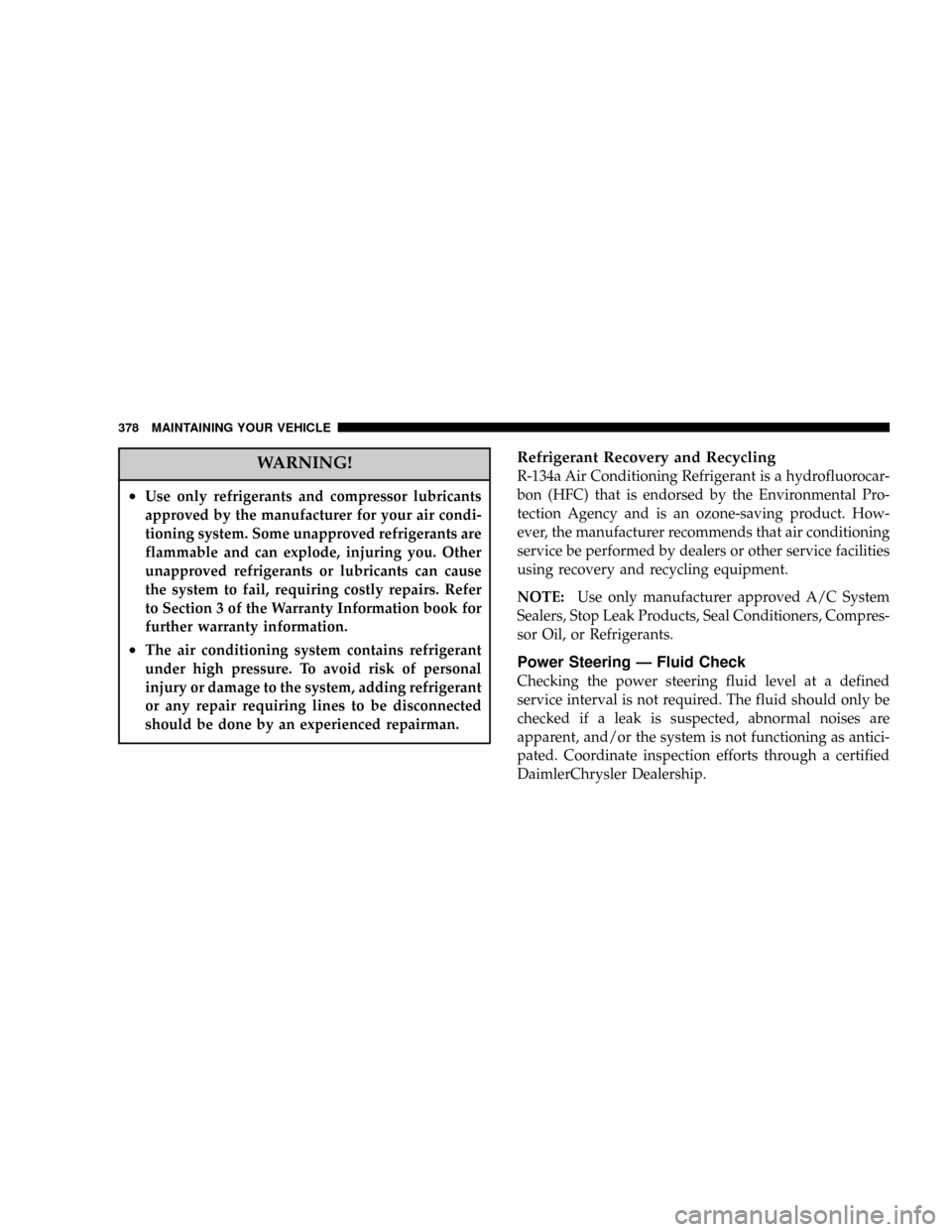
WARNING!
²Use only refrigerants and compressor lubricants
approved by the manufacturer for your air condi-
tioning system. Some unapproved refrigerants are
flammable and can explode, injuring you. Other
unapproved refrigerants or lubricants can cause
the system to fail, requiring costly repairs. Refer
to Section 3 of the Warranty Information book for
further warranty information.
²The air conditioning system contains refrigerant
under high pressure. To avoid risk of personal
injury or damage to the system, adding refrigerant
or any repair requiring lines to be disconnected
should be done by an experienced repairman.
Refrigerant Recovery and Recycling
R-134a Air Conditioning Refrigerant is a hydrofluorocar-
bon (HFC) that is endorsed by the Environmental Pro-
tection Agency and is an ozone-saving product. How-
ever, the manufacturer recommends that air conditioning
service be performed by dealers or other service facilities
using recovery and recycling equipment.
NOTE:Use only manufacturer approved A/C System
Sealers, Stop Leak Products, Seal Conditioners, Compres-
sor Oil, or Refrigerants.
Power Steering Ð Fluid Check
Checking the power steering fluid level at a defined
service interval is not required. The fluid should only be
checked if a leak is suspected, abnormal noises are
apparent, and/or the system is not functioning as antici-
pated. Coordinate inspection efforts through a certified
DaimlerChrysler Dealership.
378 MAINTAINING YOUR VEHICLE
Page 379 of 467
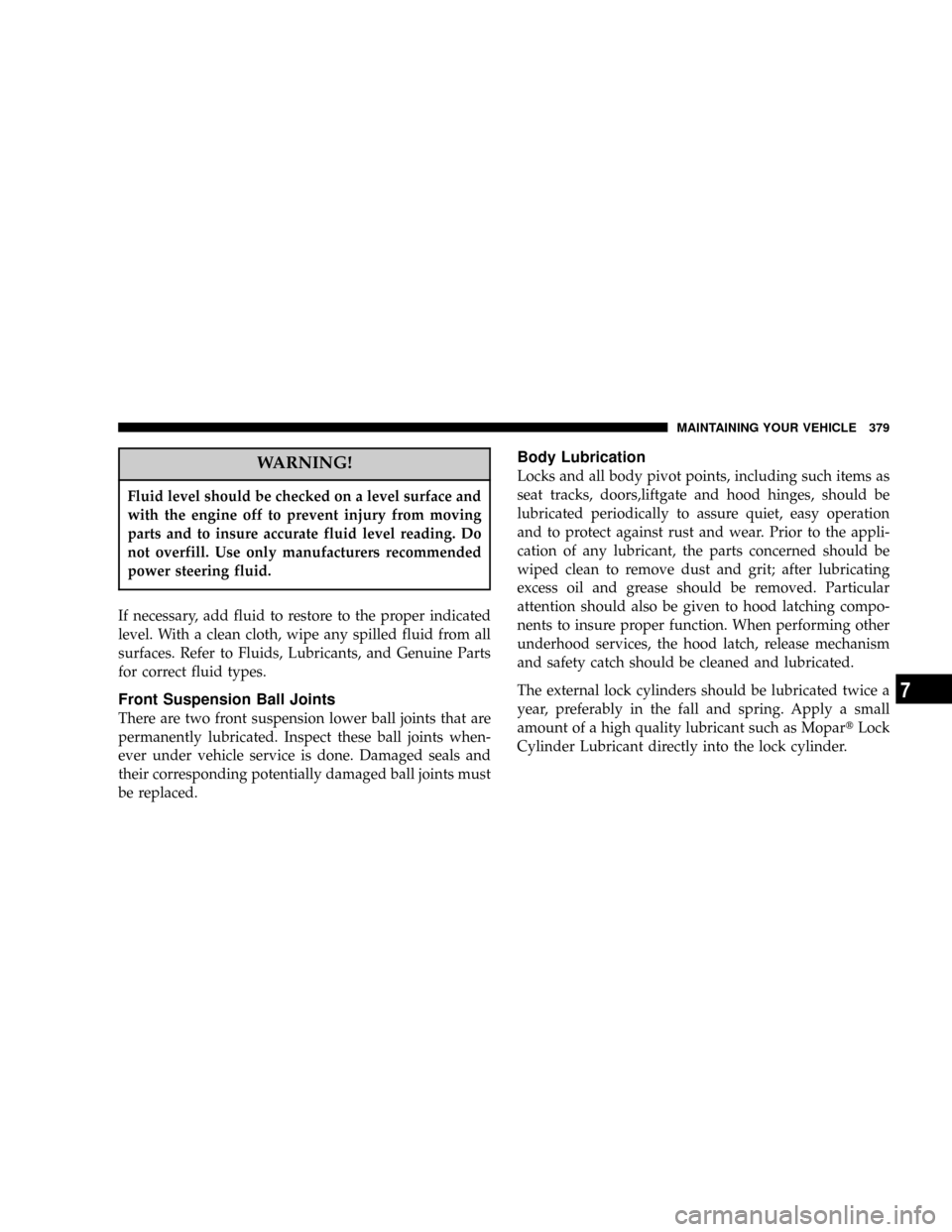
WARNING!
Fluid level should be checked on a level surface and
with the engine off to prevent injury from moving
parts and to insure accurate fluid level reading. Do
not overfill. Use only manufacturers recommended
power steering fluid.
If necessary, add fluid to restore to the proper indicated
level. With a clean cloth, wipe any spilled fluid from all
surfaces. Refer to Fluids, Lubricants, and Genuine Parts
for correct fluid types.
Front Suspension Ball Joints
There are two front suspension lower ball joints that are
permanently lubricated. Inspect these ball joints when-
ever under vehicle service is done. Damaged seals and
their corresponding potentially damaged ball joints must
be replaced.
Body Lubrication
Locks and all body pivot points, including such items as
seat tracks, doors,liftgate and hood hinges, should be
lubricated periodically to assure quiet, easy operation
and to protect against rust and wear. Prior to the appli-
cation of any lubricant, the parts concerned should be
wiped clean to remove dust and grit; after lubricating
excess oil and grease should be removed. Particular
attention should also be given to hood latching compo-
nents to insure proper function. When performing other
underhood services, the hood latch, release mechanism
and safety catch should be cleaned and lubricated.
The external lock cylinders should be lubricated twice a
year, preferably in the fall and spring. Apply a small
amount of a high quality lubricant such as MopartLock
Cylinder Lubricant directly into the lock cylinder.
MAINTAINING YOUR VEHICLE 379
7
Page 388 of 467
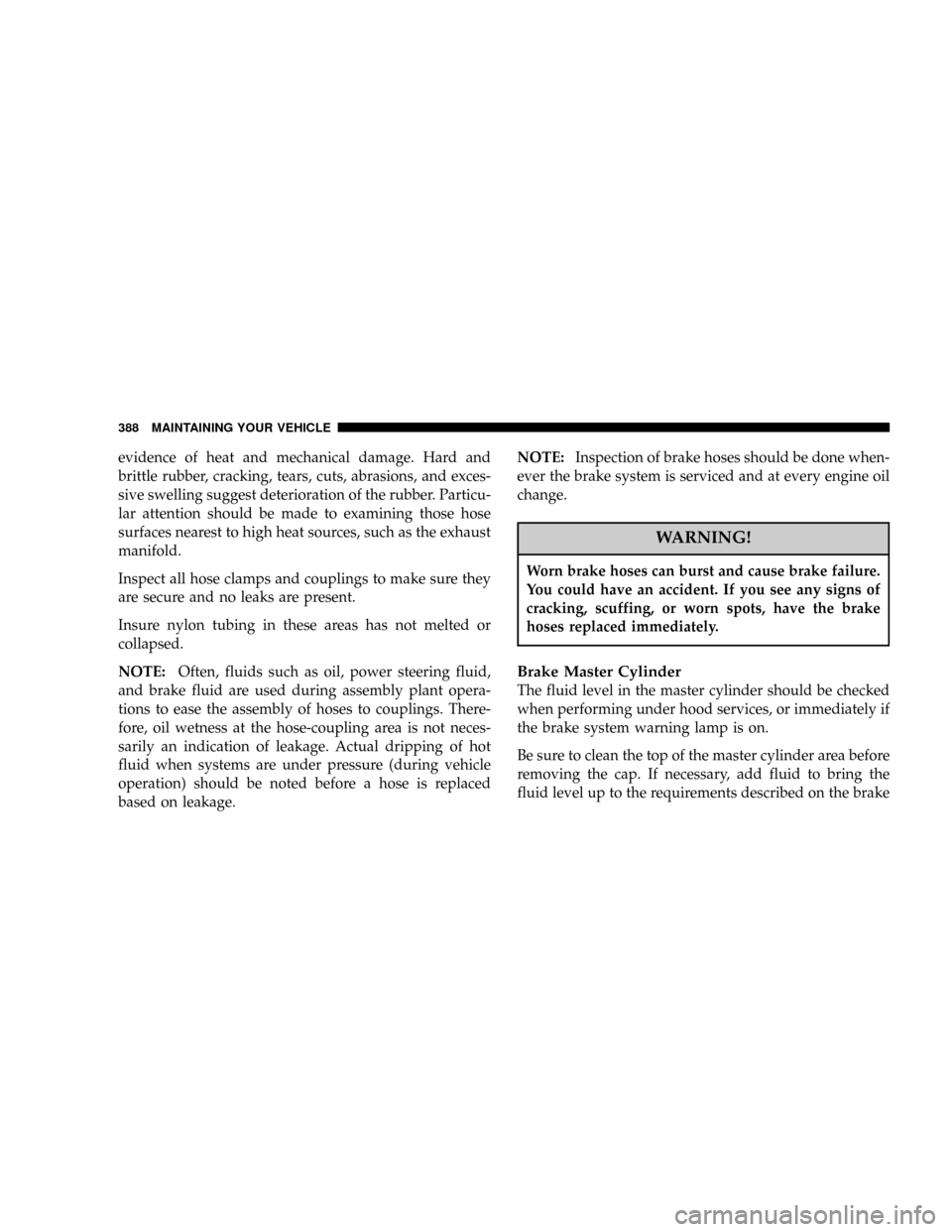
evidence of heat and mechanical damage. Hard and
brittle rubber, cracking, tears, cuts, abrasions, and exces-
sive swelling suggest deterioration of the rubber. Particu-
lar attention should be made to examining those hose
surfaces nearest to high heat sources, such as the exhaust
manifold.
Inspect all hose clamps and couplings to make sure they
are secure and no leaks are present.
Insure nylon tubing in these areas has not melted or
collapsed.
NOTE:Often, fluids such as oil, power steering fluid,
and brake fluid are used during assembly plant opera-
tions to ease the assembly of hoses to couplings. There-
fore, oil wetness at the hose-coupling area is not neces-
sarily an indication of leakage. Actual dripping of hot
fluid when systems are under pressure (during vehicle
operation) should be noted before a hose is replaced
based on leakage.NOTE:Inspection of brake hoses should be done when-
ever the brake system is serviced and at every engine oil
change.
WARNING!
Worn brake hoses can burst and cause brake failure.
You could have an accident. If you see any signs of
cracking, scuffing, or worn spots, have the brake
hoses replaced immediately.
Brake Master Cylinder
The fluid level in the master cylinder should be checked
when performing under hood services, or immediately if
the brake system warning lamp is on.
Be sure to clean the top of the master cylinder area before
removing the cap. If necessary, add fluid to bring the
fluid level up to the requirements described on the brake
388 MAINTAINING YOUR VEHICLE
Page 412 of 467
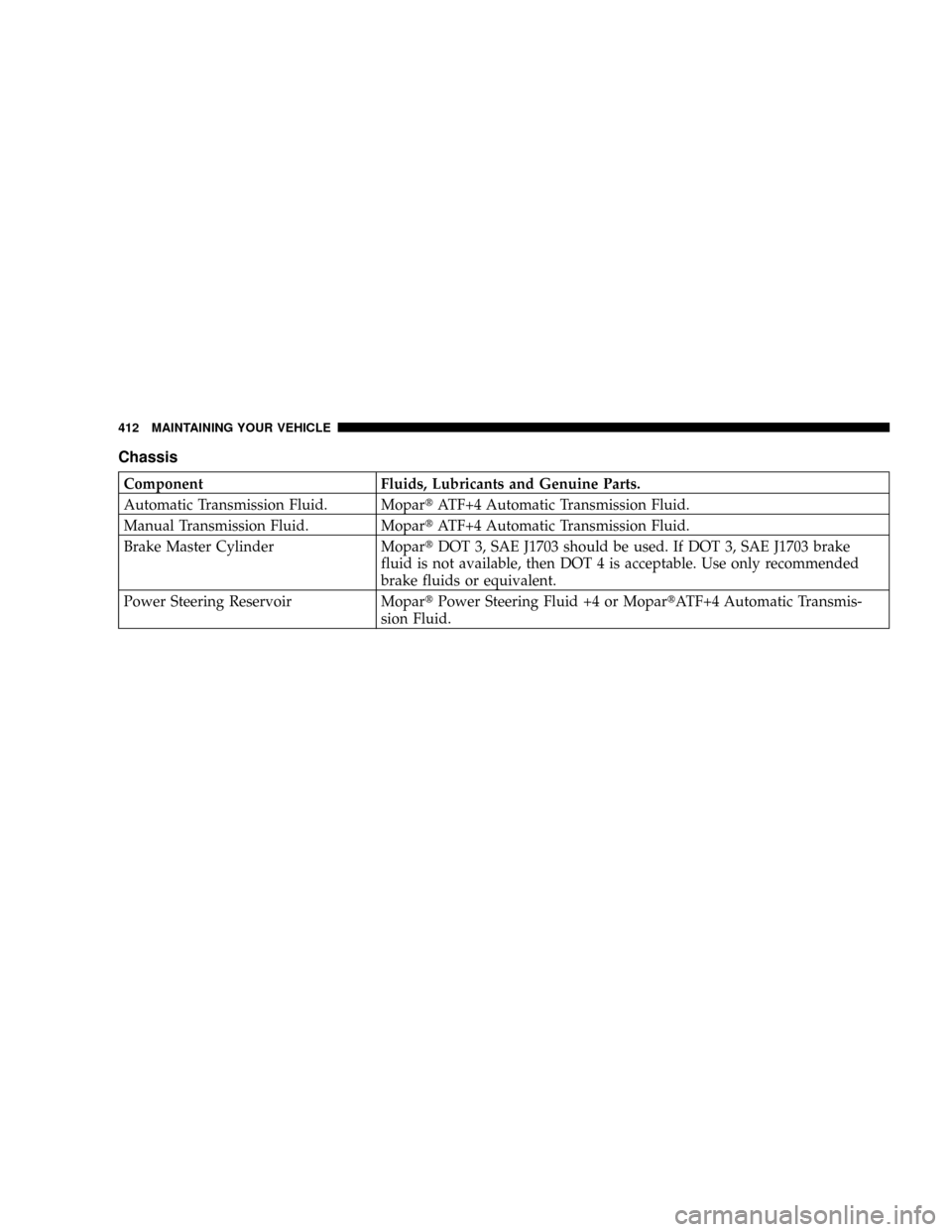
Chassis
Component Fluids, Lubricants and Genuine Parts.
Automatic Transmission Fluid. MopartATF+4 Automatic Transmission Fluid.
Manual Transmission Fluid. MopartATF+4 Automatic Transmission Fluid.
Brake Master Cylinder MopartDOT 3, SAE J1703 should be used. If DOT 3, SAE J1703 brake
fluid is not available, then DOT 4 is acceptable. Use only recommended
brake fluids or equivalent.
Power Steering Reservoir MopartPower Steering Fluid +4 or MopartATF+4 Automatic Transmis-
sion Fluid.
412 MAINTAINING YOUR VEHICLE
Page 460 of 467

Materials Added to..................... 371
Quality............................. 370
Recommendation...................370,410
Synthetic............................ 371
Viscosity............................ 370
Oil Pressure Light....................... 229
Onboard Diagnostic System..............364,365
Opener, Garage Door (HomeLinkt) ........... 193
Operator Manual (Owner's Manual)............ 4
Outside Air Intake....................... 275
Overdrive............................. 287
Overheating, Engine...................... 342
Owner's Manual (Operator Manual).........4,444
Paint Care............................. 393
Panel Rear Shelf........................ 208
Panic Alarm..........................25,32
Parking Brake.......................... 294
Passenger Seat Back Tilt (Easy Entry System).... 164Passing Light........................... 185
Personal Settings........................ 234
Pets...............................79,112
Phone, Cellular......................... 134
Phone, Hands-Free (UConnectŸ)............ 134
Placard, Tire and Loading Information......... 306
Power
Deck Lid Release....................... 40
Distribution Center (Fuses)............... 400
Door Locks........................... 20
Outlet (Auxiliary Electrical Outlet).......... 202
Seats............................... 161
Steering..........................299,378
Steering, Checking..................... 378
Sunroof............................. 200
Windows............................. 43
Power Steering Fluid..................... 412
Pregnant Women and Seat Belts............54,88
Preparation for Jacking.................... 346
460 INDEX
Page 467 of 467
INTRODUCTION INTRODUCTION HOW TO USE THIS MANUAL WARNINGS AND CAUTIONS VEHICLE IDENTIFICATION NUMBER VEHICLE MODIFICATIONS/ALTERATIONS THINGS TO KNOW BEFORE STARTING YOUR VEHICLE A WORD ABOUT YOUR KEYS
Ignition Key Removal
Locking Doors With The KeyKey-In-Ignition ReminderSENTRY KEY - IF EQUIPPED Replacement KeysSentry Key ProgrammingGeneral InformationSTEERING WHEEL LOCK - IF EQUIPPED If You Wish To Manually Lock The Steering WheelTo Release The Steering Wheel
LockAutomatic Transaxle Ignition Interlock SystemDOOR LOCKS Manual Door LocksPower Door LocksChild-Protection Door Lock System (Rear Doors) - IfEquippedREMOTE KEYLESS ENTRY (SEDAN) To unlock the doors and liftgateTo lock the doors and liftgate (if
equipped with power options) Using The Panic AlarmTo Turn Off Flash Lights With LockProgramming Additional TransmittersGeneral InformationBattery ReplacementREMOTE KEYLESS ENTRY (CONVERTIBLE) To Unlock the DoorsTo lock the doorsTo Unlatch the Deck
LidPanic AlarmUsing The Panic AlarmTo Turn Off Flash Lights With LockTo Program Additional TransmittersGeneral InformationTransmitter Battery ServiceSECURITY ALARM SYSTEM - IF EQUIPPED To set the alarmTo disarm the systemSecurity System Manual Override
LIFTGATE (SEDAN) DECK LID (CONVERTIBLE) Power Deck Lid Release (Convertible)EMERGENCY SEAT BACK RELEASE (SEDAN) EMERGENCY DECK LID RELEASE LATCH (CONVERTIBLE) POWER WINDOWS Auto Down FeatureRear Window SwitchesWind
BuffetingOCCUPANT RESTRAINTS (SEDAN) Lap/Shoulder BeltsAdjustable Upper Shoulder Belt AnchorageLap/Shoulder Belt Untwisting ProcedureSeat Belt PretensionersEnhanced Seat Belt Reminder System (BeltAlert) Seat Belts And Pregnant WomenDriver and Front
Passenger Supplemental Restraint System (SRS) - AirbagChild RestraintOCCUPANT RESTRAINTS (CONVERTIBLE) Lap/Shoulder BeltsLap/Shoulder Belt Untwisting ProcedureSeat Belt PretensionersEnhanced Seat Belt Reminder System (BeltAlert) Seat Belts And
Pregnant WomenDriver and Front Passenger Supplemental Restraint System (SRS) - AirbagChild RestraintENGINE BREAK-IN RECOMMENDATIONS SAFETY TIPS Exhaust GasSafety Checks You Should Make Inside The VehiclePeriodic Safety Checks You Should Make
Outside The VehicleUNDERSTANDING THE FEATURES OF YOUR VEHICLE CONVERTIBLE TOP OPERATION To Lower The TopTo Raise The TopConvertible Top Boot Cover Installation-If EquippedConvertible Top Boot Cover Removal and StorageCONVERTIBLE TOP
MANUAL OVERRIDEMIRRORS Inside Day/Night Mirror - If EquippedOutside Mirror-Drivers SideOutside Mirror-Passengers SideElectric Remote-Control Mirrors - If EquippedIlluminated Vanity Mirrors - If EquippedSun Visor Sliding FeatureHANDS-FREE COMMUNICATION
(UConnect) - IF EQUIPPED OperationsPhone Call FeaturesUConnect System FeaturesAdvanced Phone ConnectivityThings You Should Know About Your UConnect SystemGeneral InformationSEATS Front Seat AdjustmentPower Seat Adjuster - If EquippedManual
Lumbar-If EquippedFolding Front Passenger Seat - If EquippedDrivers Seat Back Tilt-If EquippedPassenger Seat Back Tilt (Easy Entry System) (Convertible)Adjustable Head RestraintsHeated Seats - If EquippedFolding Rear Seat (Sedan)Folding Rear Seat (Convertible)
Tumbling Rear Seat (Sedan)Tumbling Rear Seat (Convertible)Rear Seat Removal (Sedan)TO OPEN AND CLOSE THE HOOD LIGHTS Map/Reading Lights (Sedan)Map/Reading Lights (Convertible)Multi-Function Control LeverHeadlights, Parking Lights, Instrument Panel
LightsDaytime Running Lights (DRL) - If EquippedLights-on ReminderFog Lights - If Equipped Turn Signals Highbeam/Lowbeam Select Switch Passing LightWINDSHIELD WIPERS AND WASHERS Windshield WashersMist Feature Windshield Wiper OperationIntermittent
Wiper SystemTILT STEERING COLUMN ELECTRONIC SPEED CONTROL - IF EQUIPPED To ActivateTo Set At A Desired SpeedTo DeactivateTo Resume SpeedTo Vary The Speed SettingManual TransaxleTo Accelerate For PassingGARAGE DOOR OPENER - IF
EQUIPPED Programming The Universal TransceiverRolling Code ProgrammingCanadian Programming/Gate ProgrammingOperationReprogramming A Single ButtonSecurityPOWER SUNROOF - IF EQUIPPED Express Open FeatureWind BuffetingSunroof Maintenance
ELECTRICAL POWER OUTLETS Electrical Outlet Use With Engine OffCONSOLE FEATURES STORAGE Center Console/Armrest Storage Bin Storage PocketsREAR SHELF PANEL- IF EQUIPPED Position 1 (Top)Position 2 (Middle)Position 3 (Floor)Position 4 (Vertical) Position 5 (table)ROOF LUGGAGE RACK - IF EQUIPPED REAR WINDOW FEATURES Electric Rear Window Defroster Rear Wiper/Washer Switch - If EquippedAdding Washer FluidUNDERSTANDING YOUR INSTRUMENT PANEL INSTRUMENT PANEL FEATURES
INSTRUMENT CLUSTER-BASE INSTRUMENT CLUSTER-PREMIUM INSTRUMENT CLUSTER-TURBO INSTRUMENT CLUSTER DESCRIPTIONS ELECTRONIC VEHICLE INFORMATIONCENTER (EVIC)-If Equipped EVIC Functions Compass/Temperature/Audio
Average Fuel EconomyDistance To Empty (DTE)Elapsed TimePersonal Settings (Customer Programmable Features)SETTING THE ANALOG CLOCK RADIO GENERAL INFORMATION Radio Broadcast SignalsTwo Types of SignalsElectrical DisturbancesAM Reception
FM ReceptionSALES CODE REF - AM/FM/CD (SINGLE DISC) RADIO WITH OPTIONAL SATELLITE RADIO AND HANDS FREE PHONE CAPABILITY Operating Instructions - Radio ModeOperation Instructions - CD ModeOperation Instructions - Auxiliary ModeOperating
Instructions - Hands Free Phone - If EquippedOperating Instructions - Satellite Radio - If EquippedSALES CODE RAQ - AM/FM/CD (6-DISC) RADIO WITH OPTIONAL SATELLITE RADIO, HANDS FREE PHONE, AND VEHICLE ENTERTAINMENT SYSTEMS (VES)
CAPABILITIES Operating Instructions - Radio ModeOperation Instructions - (CD MODE for CD Audio Play)LOAD/EJECT Button (CD Mode for CD Audio Play)Notes On Playing MP3 FilesOperation Instructions - (CD Mode for MP3 Audio Play)LOAD/EJECT Button (CD Mode
for MP3 Play)SATELLITE RADIO - IF EQUIPPED System ActivationElectronic Serial Number/Sirius Identification Number (ESN/SID)Selecting Satellite Mode in REF, and RAQ, RadiosSelecting a ChannelStoring and Selecting Pre-Set ChannelsUsing the PTY (Program Type)
Button (if equipped)PTY Button SCANPTY Button SEEKSatellite AntennaReception QualityCD/DVD DISC MAINTENANCE RADIO OPERATION AND CELLULAR PHONES CLIMATE CONTROLS Climate ControlsOperating Tips STARTING AND OPERATING STARTING
PROCEDURES Automatic TransaxleManual TransaxleNormal StartingExtremely Cold Weather (below -20 degrees F or -29 degrees C)If Engine Fails to StartAfter StartingTurbocharger Cool DownAUTOMATIC TRANSAXLE - IF EQUIPPED Brake/Transmission Interlock
SystemAutomatic Transaxle Ignition Interlock SystemFour Speed Automatic TransaxleReset ModeGear Ranges For Four Speed Automatic TransaxleAUTOSTICK - IF EQUIPPED Autostick OperationAutostick General InformationMANUAL TRANSAXLE OPERATION 2.4
Liter Turbo- If Equipped Recommended Shift SpeedsDownshiftingPARKING BRAKE BRAKE SYSTEM Anti-Lock Brake System (ABS) - If EquippedPOWER STEERINGTRACTION CONTROL SYSTEM - IF EQUIPPED TIRE SAFETY INFORMATION Tire Markings Tire
Identification Number (TIN)Tire Loading and Tire PressureTIRES - GENERAL INFORMATION Tire PressureTire Inflation PressuresRadial-Ply TiresCompact Spare Tire - If EquippedLimited Use Spare - If EquippedTire SpinningTread Wear IndicatorsLife of TireReplacement
TiresAlignment And BalanceTIRE CHAINS SNOW TIRES Tire Rotation Recommendations FUEL REQUIREMENTS 2.4L Standard Engine and 2.4L Standard Turbo Engine2.4L High Output Turbo EngineReformulated GasolineGasoline/Oxygenate BlendsMMT In Gasoline
Materials Added to FuelFuel System CautionsCarbon Monoxide WarningsADDING FUEL Fuel Filler Cap (Gas Cap)Loose Fuel Filler Cap MessageVEHICLE LOADING TRAILER TOWING Common Towing DefinitionsTrailer Hitch ClassificationTrailer Towing Weights
(Maximum Trailer Weight Ratings)Trailer and Tongue WeightTowing RequirementsTowing TipsRECREATIONAL TOWING (BEHIND MOTORHOME, ETC.) Towing This Vehicle Behind Another Vehicle (Flat towing with all four wheels on the ground)WHAT TO DO IN
EMERGENCIES HAZARD WARNING FLASHER IF YOUR ENGINE OVERHEATS JACKING AND TIRE CHANGING Jack LocationSpare Tire StowagePreparations For JackingJacking InstructionsJUMP-STARTING PROCEDURES DUE TO A LOW BATTERY DRIVING
ON SLIPPERY SURFACES AccelerationTractionFREEING A STUCK VEHICLE TOWING A DISABLED VEHICLE With Ignition KeyWithout The Ignition KeyCONVERTIBLETOP MANUAL OVERRIDE MAINTAINING YOUR VEHICLE 2.4L TURBO ENGINE COMPARTMENT
2.4L ENGINE COMPARTMENT ONBOARD DIAGNOSTIC SYSTEM - OBD II Loose Fuel Filler Cap MessageEMISSIONS INSPECTION AND MAINTENANCE PROGRAMS REPLACEMENTPARTS DEALER SERVICE MAINTENANCE PROCEDURES Engine OilDrive Belts
- Check Condition and TensionSpark PlugsIgnition Wiring SystemCatalytic ConverterEngine Timing BeltCrankcase Emission Control SystemFuel FilterAir Cleaner Element (Filter)Maintenance-Free BatteryAir Conditioner MaintenancePower Steering - Fluid CheckFront
Suspension Ball JointsBody LubricationWindshield Wiper BladesWindshield Washer ReservoirExhaust SystemCooling SystemHoses And Vacuum/VaporHarnessesFuel System ConnectionsBrake SystemAutomatic TransaxleManual TransaxleAppearance Care And
Protection From CorrosionCONVERTIBLE TOP CARE WashingGeneral CleaningCloth Top Additional Cleaning ProcedureCloth Top ProtectionWeather Strip CareINTEGRATED POWER MODULE (IPM) VEHICLE STORAGE REPLACEMENT BULBS BULB REPLACEMENT
HeadlightsFront Park/Turn Signal/Side Marker LightsFront Fog Lights - If EquippedTail/Stop, and Rear Turn Signal LightsBack Up Lights Center HighMounted Stop LightFLUIDS AND CAPACITIES FLUIDS, LUBRICANTS AND GENUINE PARTS EngineChassis
MAINTENANCE SCHEDULES EMISSION CONTROL SYSTEM MAINTENANCE MAINTENANCE SCHEDULE SCHEDULE B-ALL ENGINESSCHEDULE A-NON TURBOSCHEDULE A-TURBOIF YOU NEED CONSUMER ASSISTANCE SUGGESTIONS FOR OBTAINING
SERVICE FOR YOUR VEHICLE Prepare For The AppointmentPrepare A ListBe Reasonable With RequestsIF YOU NEED ASSISTANCE WARRANTY INFORMATION (U.S. Vehicles Only) MOPAR PARTS REPORTING SAFETY DEFECTS In CanadaPUBLICATION ORDER
FORMS DEPARTMENT OF TRANSPORTATION UNIFORM TIRE QUALITY GRADES TreadwearTraction GradesTemperature GradesINDEX